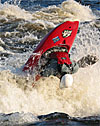How kayak users built a new industry [HBS Working Knowledge]
User innovations occur when customers of a product improve on that product with their own designs. In rodeo kayaking, the early participants built specialized kayaks from fiberglass using hand lay-up techniques; these crafts were especially nimble in rough water. In the early 1970s, other kayakers began asking these “user innovators” to create equipment for them—and the rodeo kayaking industry was born. Since then, rodeo kayaks have gone through several major design iterations, and the sport has become a $100 million business.
Baldwin and her fellow researchers wanted to better understand this path from user innovation to commercial product. What role do user communities play in this process? Are “user-manufacturers” —users who turn their improvements into commercial products—usually industry leaders? How competitive are existing, well-capitalized companies when they compete against user-manufacturers? Although there have been a number of studies on user innovation, little if any work has been done on the commercialization of user innovations, the authors believe.
The research was recently published in the working paper How User Innovations Become Commercial Products: A Theoretical Investigation and Case Study (pdf, 2.98 mb, 29 pages). The authors believe that their research “provides a first opportunity for both user-manufacturers and established manufacturers to think systematically about the dynamics of these types of markets, and to plan their business strategies accordingly.”
In an interview in Harvard Busines School’s Working Knowledge, Baldwin discusses the research and its implications for entrepreneurs who would like to become their own user innovators.
(via IdeaPort)




